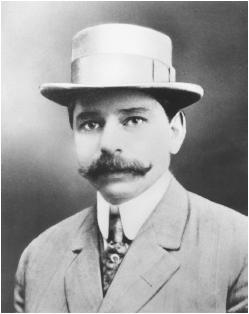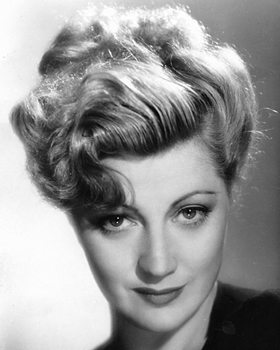In fact without the influence of these early immigrants and their offspring, the motion picture industry as we know it would be very different today.
 |
| Screen cap from Edison's New York City Fish Market |
Though the neighborhood did not get its first movie house until about 1906, these films were shown at venues across the nation, which means that the target audiences for these films were not its subjects.
In what can be chalked up to the earliest examples of "reality tv," these two-to-three minute, one-camera shorts were essentially produced for middle and upper class audiences, who for the first time were able to catch a glimpse of "how the other half lives" in the new urban ghettos of America.
Edison's titles include Panoramic View of the Ghetto (1900), New York City Ghetto Fish Market (1903), Move on (1903), East Side Urchins Bathing in a Fountain (1903), and New York City Public Bath (1903).
Portrayals of immigrants were largely unfavorable, often inspiring curiosity and amusement in captive audiences. It wasn't until the 1920s that immigrants were depicted sympathetically on the big screen.
It was the sons and daughters of these very slums who, through the medium of film, helped change the public's perception of the immigrant experience – at the same time altering the direction of the entire entertainment industry.
American Vaudeville, which was refined at Tony Pastor's Opera House on the Bowery in the 1870s, was a primary influence in development of early film and radio. By the time that the iconic "vaudeville hook" was introduced at Miner's Bowery Theater in 1902, immigrants had infused their brand of song, dance and comedy which made the format so successful on the big screen.
 |
| George Burns and Gracie Allen began on the vaudeville stage. |
Another major influence on Hollywood was Yiddish Theatre, brought to America from Eastern Europe in 1884 and incubated in the tenement district of the Lower East Side. So much so that Second Avenue between Houston and 14th Streets became known as the Yiddish Rialto (Jewish Broadway) and was highly regarded as a cradle for fine dramatic theater in this city.
Many of America's earliest film and radio stars graduated from these vaudeville and immigrant theatre stages but more than that, the culture bred some of the film industry's original power brokers and innovators of the modern movie-going experience.
 |
| Adolph Zukor, founder of Paramount Pictures |
By 1903, Zukor, an upholstery shop apprentice-turned-successful furrier, took a gamble and invested in the first motion picture theater chain in America, headed by two brothers from Buffalo named Mitchel and Moe Mark. By 1912 Zukor launched his own film distribution company, which ever since a 1927 merger has been known as Paramount Pictures.
 |
| Marcus Loew, founder of Loew's Theaters & MGM |
Some of Loew's earliest associates and partners were fellow Lower East Siders and future industry moguls Joseph Schenck (1878-1961) and Nicholas Schenck, (1881-1961) who founded 20th Century Pictures – and William Fox (1879-1952) – who founded the Fox Film Corporation. In 1935 these studios merged and created 20th Century Fox.
It was men like Loew, Fox and the Schenck brothers who brought the motion picture industry to the masses by constructing dozens of theaters in working-class neighborhoods throughout the United States.
 |
| William Fox, co-founder of 20th Century Fox |
By this time, the bulk of the movie industry had relocated to the cavernous studios of Hollywood and much of the street scape was reproduced on a sound stage. Regardless, success was overwhelming and working-class audiences flocked to theaters, treated to such East Side-themed films as The Miracle of Manhattan (1921), Hungry Hearts (1922), The New Teacher (1922), His People (1925), The Patent Leather Kid (1927), Danger Street (1928), The Madonna of Avenue A (1929), and The Younger Generation (1929).
 |
| Al Jolson |
The story of a local singer caught between dreams of stardom and his family's traditional Jewish values crossed over class boundaries and proved to be a commercial success.
By the 1930s several film productions went on to capitalize on the new-found popularity of the district, like 1931s Sidewalks of New York. Here Buster Keaton, in one of his earliest talkie film roles, plays a Lower East Side slumlord who falls in love with a poor tenement girl. While pursuing his love interest, Keaton gets caught up with a band of local street toughs and ends up mixing it up with a small time hood.
This portrayal of the rough and tumble East Side became a recurring theme in countless productions during cinema's most formative years, which coincided with a nation's waning support of a decade long ban on alcohol and a severe economic depression, giving rise to character that would become an icon of the big screen – the American Gangster.
 |
| Edward G. Robinson |
Robinson's on-screen persona went on to define the Hollywood gangster – a character which was parodied for generations (do you remember this Bugs Bunny cartoon? Or the frog in the Courageous Cat and Minute Mouse cartoon?) Though he never completely shook the tough-guy image, Robinson's career spanned seven decades, earning him an honorary Oscar in 1973.
 |
| James Cagney |
A series of popular comedic films released between the late 1930s and 1950s further exploited the Lower East Side's gritty reputation. Little Tough Guys, Dead End Kids, and The Bowery Boys followed the adventures of a group of bungling local street kids and inspired several knockoffs, including The Gas House Gang (1939, 1942) and The Harlem Tuff Kids (1946, 1947).
 |
| Stella Adler |
Perhaps the only person to give Stella Adler a run for her money was "father of method acting in America," Lee Strasberg (1901-1982), whose family immigrated to the Lower East Side from the Ukraine in 1909.
 |
| Lee Strasberg |
And what would the movie going experience be without a film score? Some of America's most respected composers and lyricists hail from the Lower East East Side.
Eight-time Academy Award nominated composer Irving Berlin (1888-1989), who penned such classics as "Putting on the Ritz," "White Christmas," and "There's No Business Like Show Business," started out as a singing waiter in the most raucous Bowery dives.
George Gershwin (1898-1937), who got his first piano while growing up on Second Avenue, is often remembered as a stage composer; However he provided the score to a handful of films before his untimely passing, including the song "They Can't Take That Away from Me," which earned an Oscar nomination for the Best Song in 1937. Sharing that nomination was George's brother and writing partner, Ira Gershwin (1896-1983), who is considered one of the greatest songwriters of the 20th century.
 |
| Edgar Yipsel Harburg |
Though not officially credited, Harburg played a larger role behind the scenes of the movie. He acted as script supervisor, helped with casting and wrote in several classic scenes.
Other pioneering Lower East Side to Hollywood transplants include Eddie Cantor, Jimmy Durante, George Burns, John Garfield and dozens more, such as Tony Curtis, Estelle Getty, Walter Matthau, Zero Mostel, and Jerry Stiller who all attended the same high school, Seward Park on Essex Street.
Without the contributions of these immigrants and their offspring, where would the entertainment industry be? What we covered here is just the tip of the iceberg. In the future we will to delve into the pioneers of television, radio, Broadway and the music industry who hailed from the Lower East Side.
Other pioneering Lower East Side to Hollywood transplants include Eddie Cantor, Jimmy Durante, George Burns, John Garfield and dozens more, such as Tony Curtis, Estelle Getty, Walter Matthau, Zero Mostel, and Jerry Stiller who all attended the same high school, Seward Park on Essex Street.
Without the contributions of these immigrants and their offspring, where would the entertainment industry be? What we covered here is just the tip of the iceberg. In the future we will to delve into the pioneers of television, radio, Broadway and the music industry who hailed from the Lower East Side.
No comments:
Post a Comment